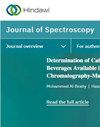DBDMA染料的电子吸收和发射光谱研究:溶剂效应、能量转移和荧光猝灭
IF 2.1
4区 化学
Q4 BIOCHEMICAL RESEARCH METHODS
引用次数: 0
摘要
研究了DBDMA(2-(1-(二氟硼烷基)-1,2-二氢喹啉-2-基)-2-(1-甲基喹啉-2-乙基)乙腈)在不同溶剂中的电子吸收和发射光谱。这两种类型的光谱都是在理论和实验中得到的。测试了染料的光稳定性,研究了其在氧和水合硫酸铜猝灭剂存在下的能量传递行为。我们还定性地估计了酸性介质对吸收和发射光谱的影响。许多光物理参数的计算值与实测值具有良好的相容性。DBDMA在不同极性的溶剂中具有较低的化学量子产率,而荧光量子产率足够高,再加上激发态寿命值较低,证实了其在波长发射最大值范围内作为激光发射染料的效率。DBDMA分子的刚性是光化学稳定性的主要原因,并且由于溶剂极性的变化而没有相当大的变化。分别利用密度泛函理论(DFT)和时变密度泛函理论(TD-DFT)优化了基态和激发态的几何形状。利用TD-DFT方法,绘制了DBDMA分子在不同溶剂中的紫外-可见吸收光谱和发射光谱。由于化合物的刚性,随着溶剂的变化,最大发射和吸收波长的位置发生了微小的变化。氧猝灭作用不明显。此外,在O2曝气20 min后,DBDMA的激发态未见系统间交叉(ISC),这可以解释染料暴露于氧气后峰值发射强度的稳定性。并计算了能量传递速率常数。本文章由计算机程序翻译,如有差异,请以英文原文为准。
A Study of the Electronic Absorption and Emission Spectra of DBDMA Dye: Solvent Effect, Energy Transfer, and Fluorescence Quenching
This study is aimed to shed light on the electronic absorption and emission spectra of DBDMA (2-(1-(difluoroboraneyl)-1,2-dihydroquinolin-2-yl)-2-(1-methylquinoxalin-2-ylidene) acetonitrile) in different solvents. Both types of spectra were obtained theoretically and produced experimentally in different solvents. The photostability of dye was tested, and its energy transfer behavior in the presence of oxygen and hydrated copper sulfate quenchers was investigated. We also gave a qualitative estimation of the effect of acidic media on the absorption and emission spectra. There is good compatibility between the calculated and measured values of many photophysical parameters. DBDMA has a low chemical quantum yield in solvents of different polarities, and the fluorescence quantum yield is high enough, which confirms, together with the low values of the excited state lifetime, its efficiency as laser emitting dye in the range of wavelength emission maxima. The rigidity of the DBDMA molecule is the main reason for the photochemical stability and the absence of a considerable shift as a result of the change in the polarity of the solvents. Geometries of ground and excited states were optimized using the density functional theory (DFT) and the time-dependent density functional theory (TD-DFT), respectively. Upon using the TD-DFT method, the UV-Vis absorption and emission spectra of the DBDMA molecule in different solvents were illustrated. A slight change is observed in the position of the maximum emission and absorption wavelength with the change of the solvent due to the rigidity of the compound. There was no apparent effect of quenching by oxygen. Besides, no intersystem crossing (ISC) was observed for the excited state of the DBDMA as a result of aeration of a solution with O2 for 20 min, which was an explanation of the stability of peak emission intensity of dye after exposure to oxygen gas. The energy transfer rate constant has been calculated as well.
求助全文
通过发布文献求助,成功后即可免费获取论文全文。
去求助
来源期刊

Journal of Spectroscopy
BIOCHEMICAL RESEARCH METHODS-SPECTROSCOPY
CiteScore
3.00
自引率
0.00%
发文量
37
审稿时长
15 weeks
期刊介绍:
Journal of Spectroscopy (formerly titled Spectroscopy: An International Journal) is a peer-reviewed, open access journal that publishes original research articles as well as review articles in all areas of spectroscopy.
 求助内容:
求助内容: 应助结果提醒方式:
应助结果提醒方式:


